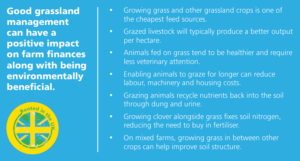In sheep production, where margins are incredibly tight, high-quality grass can be the key to profitability – so keeping a constant supply in front of livestock makes sound financial sense.
Perfecting grazing pressure Throughout the growing season it is important to carefully manage grazing pressure to ensure both good grass quality and high forage yield. Naturally, there will need to be some adjustments throughout the grass-growing season, depending on weather and other external factors but, get your grazing pressure and your residuals right, and fields will be fit to regrow leafy, high-quality, nutritious grass again and again.
Leafy grass can be well over 20% CP and have an ME of 11.5MJ/kg DM. The relationship between the D value of a grass to ME is 0.16. To have 11.5MJ/kg DM available, a grass plant must be 71.8% digestible. Managing grazing heights closely means that a sward is more likely to maintain its leafy growth and not become too mature and put out a seed head, which will reduce digestibility and affect the level of energy and protein available to the grazing sheep. Managing grass to the advised heights, particularly for ryegrass, will maintain the levels of live fresh leaf up to the three-leaf stage and minimise both seed heads and the gathering of older, dead unpalatable material at the base of the sward.
An added benefit of having animals graze ground is that they recycle nutrients back into the whole area through dung and urine. When they rely on larger volumes of silage or concentrate, more time is spent in smaller areas, putting more nutrients here but also putting more pressure on soil structures.
Correcting high grazing pressure
 If grazing pressure becomes too high, it will result in short pasture stubble and sheep are forced to consume poorer quality forage. Periods of excessively high grazing pressure will result in decreased grass production, with slow regrowth and the plant becoming low in carbohydrate reserves. The persistency of the sward and its ability to grow away in spring will also be considerably reduced. The most effective solution is to remove some sheep or buffer feed with silage or concentrate. With low grazing pressure, animal gain per head per day will typically be higher but production levels per acre will be poor. Where there is a need to increase grazing pressure this can be achieved by intensifying the stocking rate or, a paddock/field can be taken out of the grazing rotation to be silaged. If neither is possible, topping with a rotary mower or topper to remove tall, rank vegetation and encourage new growth can also be helpful.
If grazing pressure becomes too high, it will result in short pasture stubble and sheep are forced to consume poorer quality forage. Periods of excessively high grazing pressure will result in decreased grass production, with slow regrowth and the plant becoming low in carbohydrate reserves. The persistency of the sward and its ability to grow away in spring will also be considerably reduced. The most effective solution is to remove some sheep or buffer feed with silage or concentrate. With low grazing pressure, animal gain per head per day will typically be higher but production levels per acre will be poor. Where there is a need to increase grazing pressure this can be achieved by intensifying the stocking rate or, a paddock/field can be taken out of the grazing rotation to be silaged. If neither is possible, topping with a rotary mower or topper to remove tall, rank vegetation and encourage new growth can also be helpful.
For further information on NWF Sheep Feeds, please click HERE.
By Barenbrug Agricultural Key Accounts Manager, Roger Bacon.

